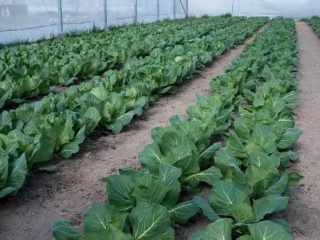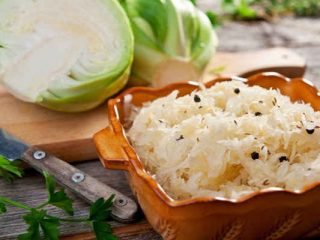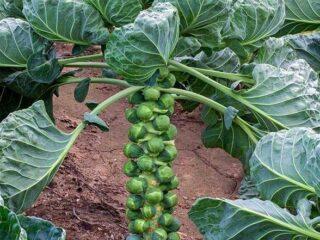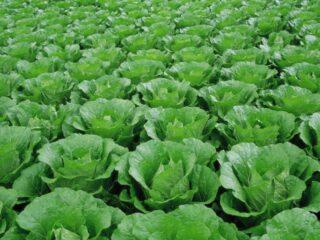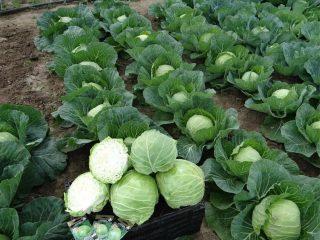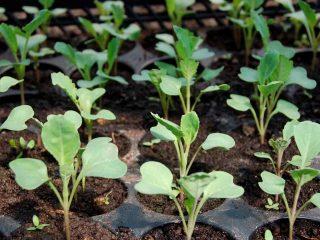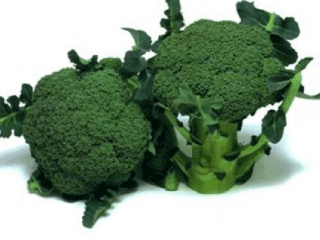Content
Many gardeners neglect hilling cabbage, although this is an extremely useful procedure for most of its varieties. It will not take much time and effort, but it will provide the rosettes with a powerful root system, which directly affects the volume and quality of the future harvest. A correctly carried out procedure cannot harm the plants, so you need to study its important nuances in advance: when, how many times to hill cabbage in open ground and how exactly to proceed.
Why do you spud cabbage?
It is useful to hill up both cabbage seedlings soon after transplanting into the ground and adult rosettes:
- The process of formation of lateral fibrous roots is activated, and the main taproot goes deeper into the soil. The plant becomes able to “pull” more moisture and nutrients from the soil and more successfully resists negative external influences.
- Plants often pick up pathogens through their lower leaves from the ground. If you hill up the cabbage, the rosette remains vertical and does not touch the ground.Accordingly, the risk of developing fungal and other diseases is reduced.
- Many pests lay their eggs in the surface layer of soil (cabbage fly, white moth and cutworm), and their larvae live there in the early stages of development. If cabbages are hilled, this “destroys” their shelter and the pest population decreases.
- The roots are covered with a thick layer of substrate. It acts as mulch, preventing them from “overheating” in the heat.
- If you regularly hill up the cabbage, you can avoid loosening. The soil does not “cake” into an airtight crust; normal aeration is maintained, without which the growth and development of roots is impossible.
- After hilling in open ground, cabbage yield increases. The formation of larger heads of cabbage becomes possible thanks to a developed root system that can provide them with water and nutrients.
- If the roots and stem are not able to “support” the head of cabbage, it bends under its weight and the cabbage falls to the ground. When growing mid-late or late-ripening varieties and hybrids, this is almost inevitable when the rosettes do not spud. Such “lying” heads of cabbage develop unevenly, have an asymmetrical shape, and often rot. In addition, caring for them is quite problematic.
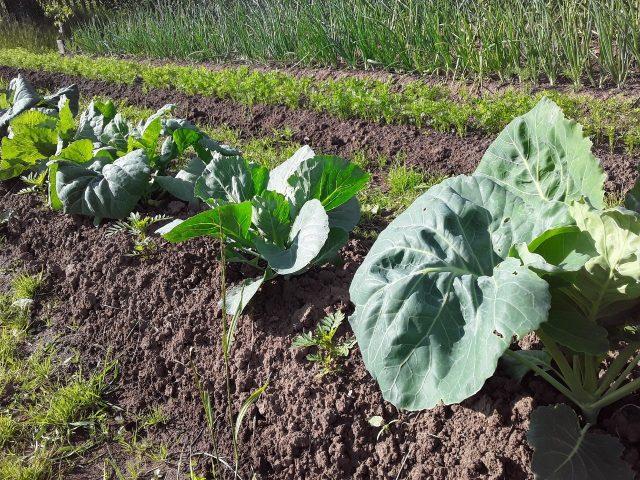
The aesthetics of planting is also an important nuance; hilled beds look much neater
How many times to hill cabbage
Most gardeners “fully” hill cabbage 2-3 times during the season. However, if after watering the soil in the garden bed is loosened and weeded, it is useful to “rake” a little substrate to the roots each time.
The only exception is cabbage, which is planted in the fall. It is hilled only once; further this procedure is not necessary.
When growing cabbage in “heavy” clay soil, it is recommended to hill up the rosettes more often - on average twice a month during the entire growing season. Regular procedures prevent water from stagnating at the roots.
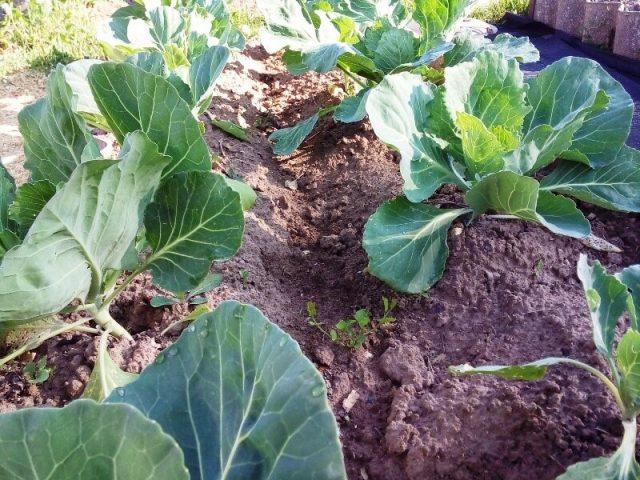
Some gardeners practice regular hilling, regardless of the quality of the substrate.
In sandy soil, it is even harmful to hill up too much. Water evaporates from this soil faster than usual.
Accordingly, in addition to the gardener’s personal preferences, the number of hillings depends on the following factors:
- features of the local climate;
- quality of planting material;
- type of substrate.
When to hill cabbage in open ground
It is impossible to indicate exact dates. In the case of seedlings, they are determined based on their condition. Then, during the season, the most suitable scheme is selected, taking into account the length of the growing season, the size of the heads of cabbage, the type of substrate and other factors. There is some “certainty” about when to hill up cabbage when planting it in the fall, but here, too, not everything is clear.
After transplanting seedlings into the ground
After transplanting the seedlings to a permanent location, the procedure is carried out after 10-16 days. During this time, the seedlings have time to “take root” in the open ground and get stronger, the risk of breaking thin, fragile stems is significantly reduced.
However, weak, elongated cabbage seedlings need to be earthed up as soon as possible, even despite the possibility of mechanical damage to the stems. Such plants especially need “support”. If hilling is neglected, they can easily be broken by the wind, and they often fall to the ground.
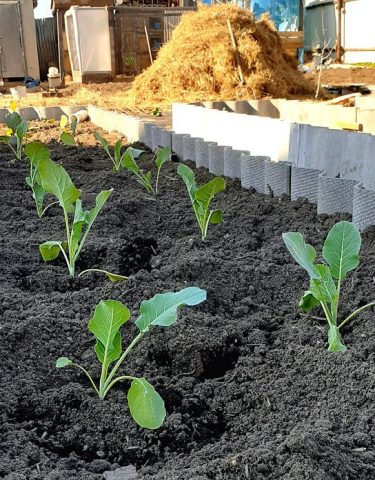
Early procedure contributes to better “survival” of seedlings
Planted in autumn
Most gardeners who plant cabbage in the fall hill it up a week after transplanting it to the garden bed and believe that this can be limited to a single procedure. A less common scheme involves repeated hilling after another 7-10 days, when the substrate “settles” by about 10 cm. Before this, you need to cut off 2-4 lower leaves and let the “wounds” dry in the open air. Otherwise, they begin to rot: even if the plant survives, the process of development of the head of cabbage will be greatly retarded.
How to properly hill cabbage in open ground
You need to hill cabbage in compliance with important recommendations and nuances. This is the only way the procedure will be most beneficial to the plants:
- Immediately before the procedure, it is necessary to weed the bed. Otherwise, surviving “undesirable” plants will begin to “compete” with it for water and nutrients.
- It is best to hill cabbage after heavy rainfall or watering. The procedure will prevent moisture from quickly evaporating from the soil. And after prolonged rainfall, it provides the opposite effect, allowing you to “drain” excess water.
- Cabbage is hilled with special tools - a hoe, a hoe, a hiller. This minimizes the risk of mechanical damage to the roots.
- During the procedure, only the surface layer of soil is “touched” (up to 5-7 cm in depth). The reason is the same - the risk of “injuring” the roots. “Work” the soil thoroughly, breaking up all the lumps, achieving its softness. This is the only way to ensure normal air exchange.
- You need to hill up the cabbage so that soil particles do not fall into the center of the rosette. This often provokes the development of rot.During the first procedure, you cannot cover the seedlings with lumps of earth, otherwise their development will be greatly “inhibited”.
- During the second and subsequent hillings, the soil is “raked” to a height of 25-30 cm. If everything is done correctly, a “hole” is formed approximately 40 cm in diameter and 5-8 cm deep. Subsequently, it is very convenient to use it for root feeding with nutrient solutions.
- The benefit of a gardener hilling cabbage is largely lost if the procedure is not combined with proper watering. It is especially important to systematically moisten the soil for seedlings after the first hilling. It is watered frequently and abundantly, spending from 30 l/m² weekly (depending on the quality of the substrate).
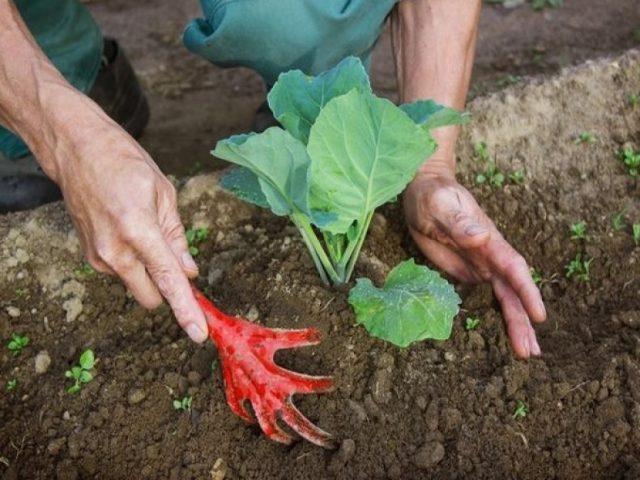
The tool is chosen taking into account the subjective ease of working with it
Hilling other types of cabbage
In addition to the “classic” white cabbage, gardeners also grow other varieties of cabbage. Most of them also need to be hilled: the general rules and basic principles are preserved, but there are also nuances that need to be taken into account in order for the procedure to benefit the culture.
Is it necessary to hill broccoli?
Broccoli needs to be hilled more often than white cabbage. The first time the procedure is carried out 18-20 days after transplanting the seedlings to a permanent place, then at intervals of a week (maximum one and a half) until harvesting. Most often it is combined with weeding the beds. You need to act carefully, “raking” the soil to the stems in small portions.
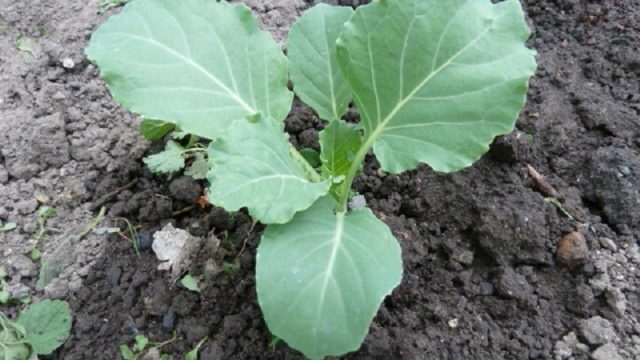
Hilling broccoli is much easier if you first moisten and loosen the substrate well.
A low “hill” is formed around the rosettes - 5-6 cm. This level must be maintained every time. Do not hill broccoli stems higher than during the previous procedure.
Do you spud cauliflower?
Cauliflower is hilled three times during the season:
- a week and a half after transplantation to a permanent place;
- after 6-8 days from the appearance of the first inflorescences;
- at the stage of active mass gain by the head.
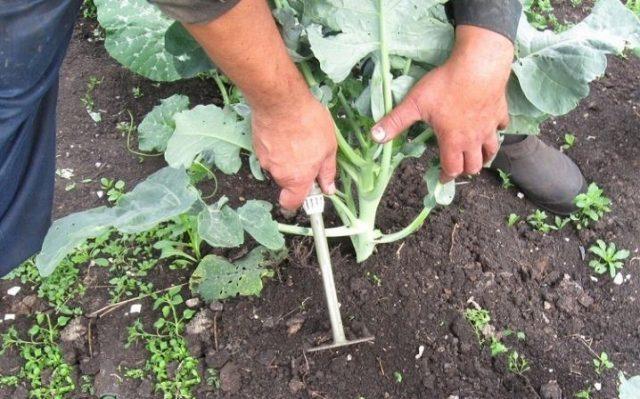
During the second and third hilling of cauliflower, the lower leaves are removed each time
Is it necessary to hill kohlrabi?
Hilling kohlrabi is strongly not recommended, as this can lead to crop loss. Its stem fruits are located half above the ground, and it is easy to “injure” them in the process. Even microdamages provoke the appearance of cracks and “wormholes”, sharply increasing the risk of infection by pathogens and attack by pests.
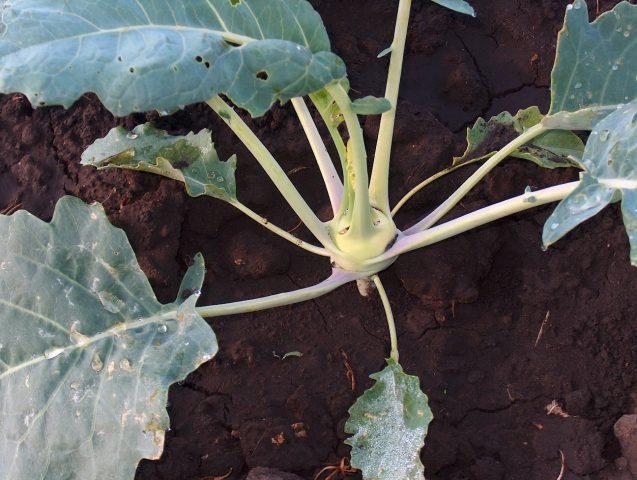
When growing kohlrabi cabbage, it is better to limit yourself to carefully loosening the rows and mulching the beds
Post-procedure care
Cabbage does not need any specific care after it has been spudded. Enough competent agricultural technology:
- Watering. The intervals between them are adjusted taking into account air temperature, intensity and frequency of precipitation. It should be taken into account that it is especially sensitive to moisture deficiency during the first 1.5-2 weeks after transplanting to the garden bed and at the stage of setting heads.
- Mulching. An optional procedure, but some gardeners, in addition to hilling, fill the rows with mulch. This helps save time on weeding and prevent the soil that was “raked” to the sockets from crumbling.
- Feeding. If the cabbage is clearly lagging behind in development, 3-5 days after it is hilled up, you can carry out foliar feeding with a solution of any biostimulant.
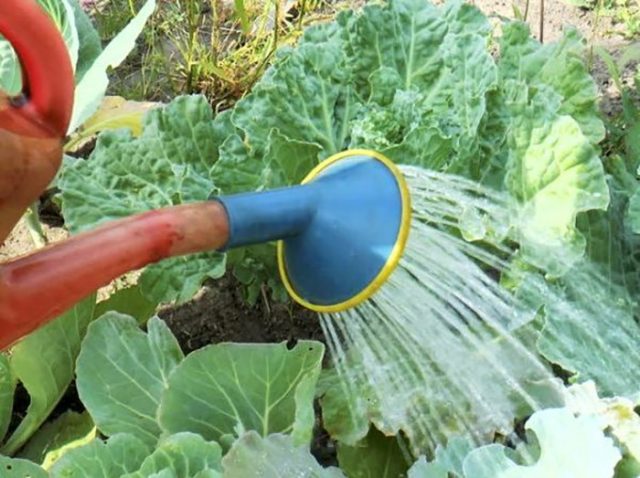
The best method of watering for white cabbage is sprinkling.
Conclusion
By and large, it is not necessary to hill up cabbage in open ground: it successfully takes root without it, develops normally and brings good harvests. However, this procedure has a very beneficial effect on the development of the root system and the “health state” of the rosettes, so it is still not recommended to neglect it. Hilling will not take much time and effort from the gardener; even an inexperienced summer resident can carry it out correctly.

